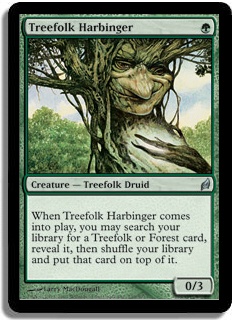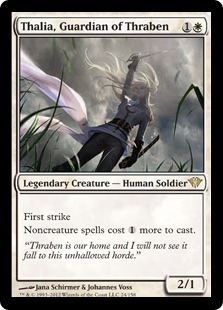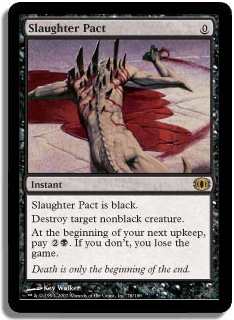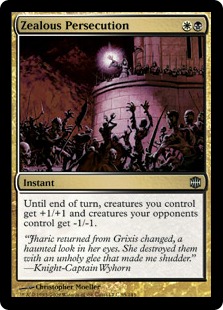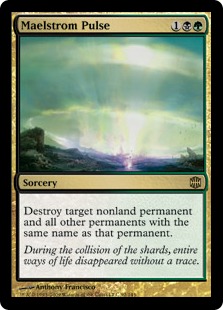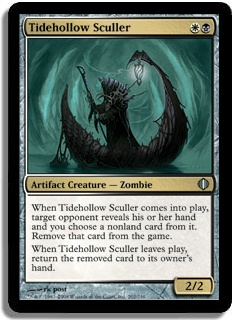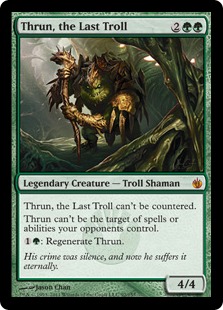To most people, Grand Prix Columbus this past weekend was just a blip on their radar, a one-of event in a rarely played format, the results of which might be interesting as a passing curiosity but little more. For much of the Magic community, Modern is a rare bird—interesting to see when it pops up, but nothing to concern yourself with most of the time. To the sixteen competitors of the upcoming Players Championship, though, Modern is the most important format in the world right now.
Fully half of the twelve rounds of the Players Championship use the Modern format, with the other six split between M13 and Cube Draft. The unique nature of the tournament makes predicting the metagame for the Constructed portion not only a totally different undertaking than usual, but also magnified in value immensely. Even a perfect read on the metagame of a Grand Prix or Pro Tour can result in unlikely pairings proving to be your downfall since the field is so huge. In a sixteen-player event with all top pros, you’re not likely to run into some totally unexpected off-the-wall deck—unless you play against Shouta, that is, and even then he’s probably just playing Tezzeret.
As a result, I’ve been paying a lot of attention to Modern in recent weeks, and I came into GP Columbus with quite a few games under my belt. A lot of people seemed to assume that I hadn’t played much because I played Doran, which I’d also played at GP Lincoln, but the reality was that I’d actually tested quite a bit and was very happy with the list going into the event. I had been winning consistently on Magic Online against pretty much everything, so I wasn’t about to swap to something else.
Here’s what I played:
Creatures (22)
- 4 Tarmogoyf
- 3 Doran, the Siege Tower
- 4 Noble Hierarch
- 4 Knight of the Reliquary
- 4 Qasali Pridemage
- 3 Thalia, Guardian of Thraben
Planeswalkers (1)
Lands (23)
Spells (14)

It’s pretty much the deck I played at GP Lincoln, minus Treefolk Harbingers and plus Thalias. Treefolk Harbinger was far and away the worst card in the deck at that tournament, and it’s only gotten worse as the format has shifted away from true combo decks like Splinter Twin and Storm and moved more toward creatures. Harbinger is at its best in a non-interactive format, since it gives you a draw that can potentially race combo decks with a turn 4 kill:
T1: Treefolk Harbinger, search for Treefolk Harbinger.
T2: Treefolk Harbinger, search for Doran, Treetop Village.
T3: Doran, attack for six.
T4:Â Activate Treetop, attack for fourteen.
As exciting as a turn 4 kill may seem, it’s about as easily disrupted as can be. Countermagic or removal for Doran turns your entire army into a bunch of Walls of Wood, which isn’t exactly the best way to kill anyone. The surge in Naya Pod combo decks means that Wall of Roots is going to be a common sight across the table, as well, which is a tough customer to take down with your own 0/3s. Not to mention Naya Pod’s popularity has led to even more decks playing even more copies of Path to Exile or similar effects, which makes the “Tree combo” that much more vulnerable.
The actual card Doran is still excellent—it’s just Treefolk Harbinger that had to go. I find that Doran seems to be one of those trap cards in deckbuilding for people. Whenever someone shows me a deck with Doran in it, it inevitably also includes cards like Harbinger or Spellskite or Skinshifter and almost never has any creatures with power greater than toughness. I understand the desire to try to maximize the power level of Doran in your deck, but it’s possible to just play with Doran because he’s effectively a three-mana 5/5. You don’t have to pack your deck full of cards that rely on Doran to be good, and you can even play some cards that lose a little bit of effectiveness with Doran in play, like Thalia.
Similarly, playing with Doran doesn’t mean you want a bunch of copies of Murmuring Bosk in your deck. Bosk was awesome back at PT Amsterdam in Extended because it was the only dual land that fetchlands could get, thanks to the absence of Ravnica duels from the format, but it’s rarely better than a shockland now. I play a single copy because it gives you some flexibility when fetching, but generally the drawback of often coming into play tapped isn’t worth the tricolor land, especially when you consider that you’ll often take as much or more damage from it over the course of a game as you would to play a shockland untapped if you actually need the white or black from it. In order to effectively play a lot of Bosks, you need a lot of Treefolk to go with them, and Doran is the only one that really makes the cut these days.
The real incentive to play Doran as compared to something like Zoo isn’t Mr. Lorax himself, but rather the black spells. Inquisition of Kozilek is an awesome catchall disruption spell against aggressive, controlling, and combo decks alike. Its value is not only in the actual effect of dismantling your opponent’s hand, but also in the information it provides that allows you to shape your gameplay around what your opponent is actually holding.
My favorite black card in the deck, though, is Slaughter Pact. Slaughter Pact is one of the most underrated cards in the entire format. Not only are there a ton of creature based decks to justify removal in general, but there are also creature based combo decks like Splinter Twin and Kiki-Jiki decks that can be absolutely crippled if they go for it while you’re tapped out and you answer with a Pact. Even if it weren’t for them, the card is amazing for when your opponents attack for what is apparently lethal, only to run their creatures into my blockers plus a Slaughter Pact to absolutely devastate them. If they don’t know you have it, they can send their creatures to their doom, and even when they do they end up playing more conservatively for fear of it.
Zealous Persecution is a card that I experimented with in Lincoln and found to be surprisingly effective. The card may look out of place, but it effectively answers a huge range of creatures in the format, from mana creatures to Dark Confidants to Spellstutter Sprites and Vendilion Cliques to tokens from Spectral Procession or Empty the Warrens to nearly every creature in Affinity. The impact of the card has decreased somewhat since the new Birthing Pod combo decks don’t include Viscera Seer, but it’s still quite effective even in creature combat just to make blocking miserable for your opponent or kill someone a turn earlier than they expect based on your clock on board.
Lastly, Maelstrom Pulse is just a good catchall solution to whatever ails you. This is the black spell in the deck I’m the least happy with because it’s not terribly efficient at what it does and Modern is very much a format of efficient threats, but I like having the flexibility to deal with a broad range of cards like Pyromancer Ascension, Vedalken Shackles, Cranial Plating, and opposing planeswalkers with a single card. The occasions when you get a two or three for one against multiple copies of the same thing are just gravy.
My performance at GP Columbus with the deck was unexciting, to say the least. I finished 4-3, with three of those wins coming from my byes, so I went 1-3 in actual played matches. I felt like I got more than a little unlucky in several of my losses, though.
My first loss came to Gaudenis playing U/W, where I took the first game and had a lethal attacker that forced him to chump block in game 2, only to have him draw Path to Exile and Baneslayer Angel in back to back turns to claw himself back from two life to winning while I drew nothing of consequence. Then I flooded out terribly in game 3. I also lost to a Naya Pod deck. In game 3, I had a pair of Tarmogoyfs to go with my Elspeth versus an empty hand when my opponent drew his single Eternal Witness to return the Kiki-Jiki I’d killed, which copied the Witness and returned Chord of Calling, allowing him to combo me out the following turn when I failed to draw another removal spell. Suffice it to say that I didn’t feel like it was my deck letting me down in those games.
I’ve played around with the deck a bit since coming back from the GP (some of which you can see in my videos here), and I’m still pretty happy with it. I don’t expect Affinity to be especially popular at the Players Championship despite its victory in Columbus, but if it is, I’ll be thrilled because it certainly is amusing to play against Cranial Plating with Doran! I’m a bit more concerned about the W/U/R Delver decks since Steppe Lynx, Delver , and Geist are much better at getting past blockers than traditional Zoo creatures are, especially backed up by Path to Exile / Vapor Snag. Inquisition does a lot of work in that matchup, but I don’t feel like it’s quite enough. I feel like I want something else to help me come back from behind, since it seems pretty hard to win on the draw when your opponent has a Steppe Lynx or flips an early Delver.
This is the deck as I’m trying it right now:
Creatures (23)
- 4 Tarmogoyf
- 3 Doran, the Siege Tower
- 2 Tidehollow Sculler
- 4 Noble Hierarch
- 4 Knight of the Reliquary
- 4 Qasali Pridemage
- 2 Thalia, Guardian of Thraben
Planeswalkers (1)
Lands (23)
Spells (13)

A pair of Tidehollow Scullers kick out one of the Thalias and the Thoughtseize, since they’re better against aggressive decks and I was probably overcompensating for Storm anyway. The addition of Sculler makes lands that produce only green mana much worse, so I cut a Treetop Village for a second Stirring Wildwood, which is a change I think I might have made anyway if only to give me a solid defensive manland against Delver, Clique, and Restoration Angel. It also attacks for more than Treetop if you have a Doran in play, so there’s always that little plus too.
Sideboard-wise, a pair of Thruns replace Reveillark and Township as tools against control and creature decks. I’m surprised I didn’t try Thrun before, since he’s an awesome body against all of the Snapcaster-removal control decks out there. He also does a great job of blocking Geist in a world where the Delver decks aren’t all playing Images—kind of funny how he’s probably better in Modern than Standard for that reason. Disfigure might just be me being silly, especially before I even have a fourth Path in the deck, but I wanted a removal spell I could play early to kill Delver and Steppe Lynx. The fact that Disfigure also conveniently kills Kiki-Jiki and mana creatures against Pod decks is a nice bonus.
Anyway, it’s unlikely that I’m going to touch on Modern too much in the near future since I’m going to go into pre-tournament radio silent mode pretty soon. As I said at the start, I know the format isn’t one that many people tend to play all that much, but I had quite a few people inquire about my deck from the GP and felt like I would be doing them a disservice if I failed to cover it. Thankfully, M13 finally hits Magic Online this week, so I’m going to get started actually playing Standard. I’ll be sure to report back on some more relevant news for the rest of you soon.
Until next time,
bmk

